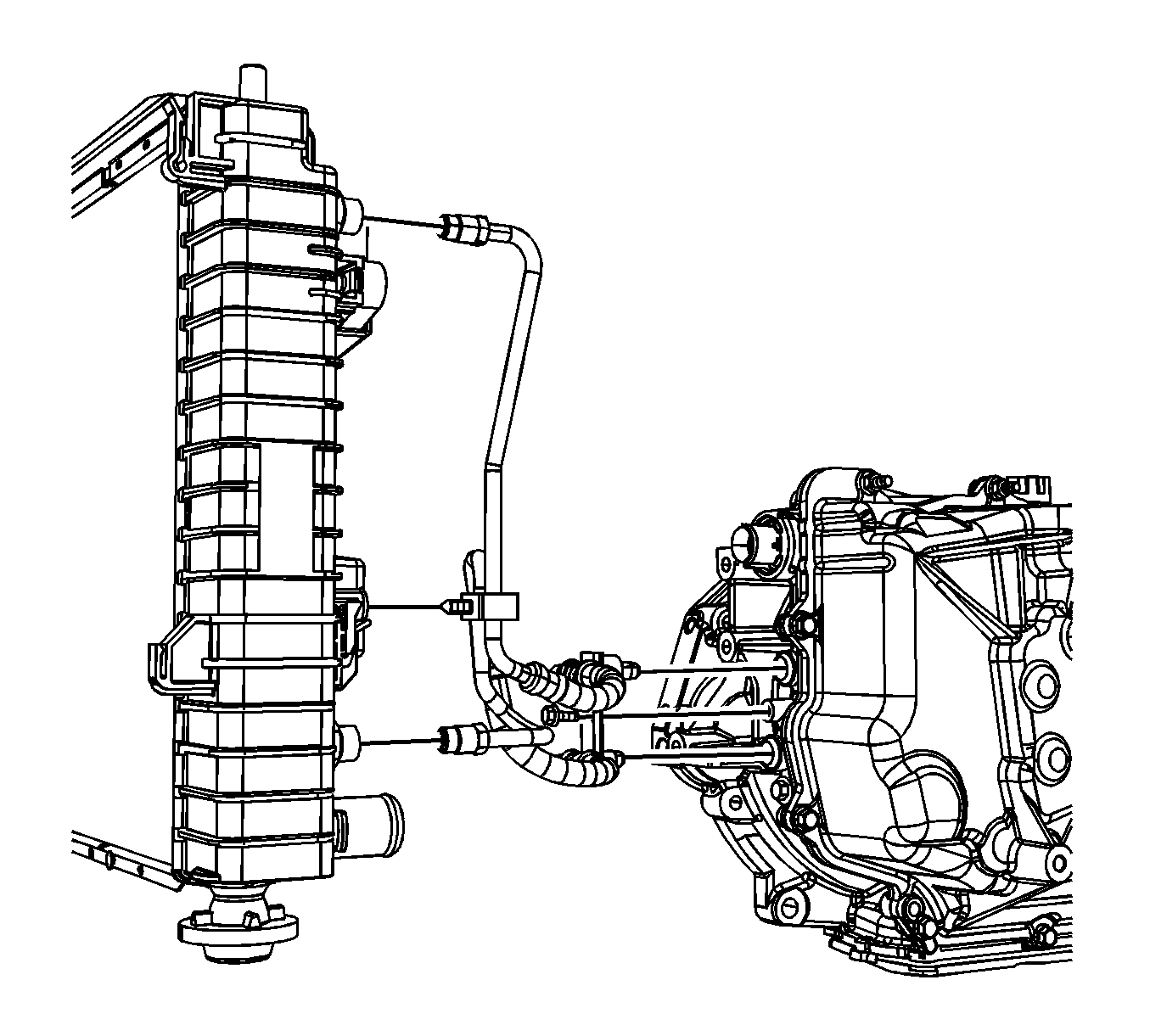Use only double-wrapped and use only brazed steel pipe meeting the GM specification 123M or equivalent if replacement of the transaxle oil cooler pipes are required. Ensure the pipe is double-flared.
Removal Procedure
- Remove the battery box. Refer to Battery Tray Replacement .
- Remove the upper transaxle oil cooler pipe fitting at the radiator.
- Raise and support the vehicle. Refer to Lifting and Jacking the Vehicle .
- Position a drain pan under the transaxle cooler pipes.
- Remove the transaxle oil cooler pipe retaining nut from the transaxle.
- Remove the transaxle oil cooler pipe from the transaxle.
- Remove the lower transaxle oil cooler pipe fitting at the radiator.
- Remove the transaxle oil cooler pipe retaining clip from the radiator.
- Remove the transaxle oil cooler pipes from the vehicle.
Notice: Allow sufficient clearance around the transaxle oil cooler pipes and around the hoses to prevent damage or wear which may cause fluid loss.

Installation Procedure
- Install the transaxle oil cooler pipes to the vehicle.
- Fasten the transaxle oil cooler pipe retaining clip to the radiator
- Install the lower transaxle oil cooler pipe fitting to the radiator.
- Install the transaxle oil cooler pipes to the transaxle.
- Install the transaxle oil cooler pipe retaining nut.
- Lower the vehicle.
- Install the upper transaxle oil cooler pipe fitting to the radiator.
- Install the battery box. Refer to Battery Tray Replacement .
- Adjust the transmission fluid level. Refer to Transmission Fluid Check .
- Inspect for fluid leaks.

Notice: Refer to Fastener Notice in the Preface section.
Important: The correct thread engagement is critical. Crossthreaded fittings can achieve proper tightness value and still leak.
Tighten
Tighten the fitting to 16 N·m (12 lb ft).
Tighten
Tighten the nut to 4 N·m (27 lb in).
Tighten
Tighten the fitting to 16 N·m (12 lb ft).
Notice: Do NOT overfill the transaxle. The overfilling of the transaxle causes foaming, loss of fluid, shift complaints, and possible damage to the transaxle.
Use only double-wrapped and use only brazed steel pipe meeting the GM specification 123M or equivalent if replacement of the transaxle oil cooler pipes are required. Ensure the pipe is double-flared.
Removal Procedure
- Remove the battery box. Refer to Battery Tray Replacement.
- Remove the upper transaxle oil cooler pipe fitting at the radiator.
- Raise and support the vehicle. Refer to Lifting and Jacking the Vehicle.
- Position a drain pan under the transaxle cooler pipes.
- Remove the transaxle oil cooler pipe retaining nut from the transaxle.
- Remove the transaxle oil cooler pipe from the transaxle.
- Remove the lower transaxle oil cooler pipe fitting at the radiator.
- Remove the transaxle oil cooler pipe retaining clip from the radiator.
- Remove the transaxle oil cooler pipes from the vehicle.
Caution: Allow sufficient clearance around the transaxle oil cooler pipes and around the hoses to prevent damage or wear which may cause fluid loss.

Installation Procedure
- Install the transaxle oil cooler pipes to the vehicle.
- Fasten the transaxle oil cooler pipe retaining clip to the radiator
- Install the lower transaxle oil cooler pipe fitting to the radiator and tighten the fitting to 16 N·m (12 lb ft).
- Install the transaxle oil cooler pipes to the transaxle.
- Install the transaxle oil cooler pipe retaining nut and tighten to 4 N·m (27 lb in).
- Lower the vehicle.
- Install the upper transaxle oil cooler pipe fitting to the radiator and tighten the fitting to 16 N·m (12 lb ft).
- Install the battery box. Refer to Battery Tray Replacement.
- Adjust the transmission fluid level. Refer to Transmission Fluid Check.
- Inspect for fluid leaks.

Caution: Refer to Fastener Caution in the Preface section.
Note: The correct thread engagement is critical. Crossthreaded fittings can achieve proper tightness value and still leak.
Caution: Do NOT overfill the transaxle. The overfilling of the transaxle causes foaming, loss of fluid, shift complaints, and possible damage to the transaxle.
